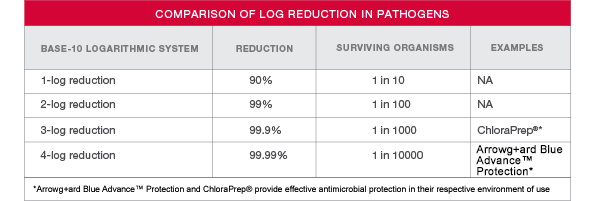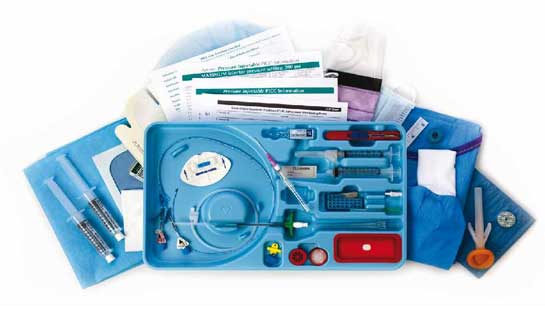First Page
Arrowg+ard Blue Advance™ PICC
Protection beyond insertion
With the increase in PICC placements, patient care has seen significant advances. However, PICCs are not without potential serious clinical complications; complications that can occur long after insertion. Not all PICCs are designed or manufactured equally. What's more, some don't offer any kind of protection at all. And when you're doing everything in your power to champion better care, why leave your patient open to serious catheter-related complications? Expect more from your PICC. Here's why you should consider a catheter that protects long after insertion:
Meet the World's first PICC that contains both Antimicrobial and Antithrombogenic Technology.3,4
We invite you to learn about the first and only multiple-protection pressure injectable PICC available today. Experience the kind of benefits that help decrease the risk of catheter-related complications:
* No correlation between in vitro / in vivo testing methods and clinical outcomes has currently been ascertained.
Back to Top View CitationsArrowg+ard Blue Advance™ Protection
Arrowg+ard Blue Advance™ Protection
The science behind the success.
Arrowg+ard Blue Advance™ Protection is an innovation designed and manufactured by experts to help you champion better care. The application of this protection involves a proprietary process that actually bonds chlorhexidine to both the internal and external catheter surfaces. This protection ensures a controlled release of chlorhexidine providing:
Antimicrobial protection*,3,4
Arrowg+ard Blue Advance™ Protection is designed to reduce microbial colonization of pathogens responsible for causing central line–associated bloodstream infections (CLABSIs).*,3,25
Antithrombogenic protection4
Arrowg+ard Blue Advance™ Protection provides an antithrombogenic effect on catheter surfaces due to the chlorhexidine coating eluting slowly over time. Arrowg+ard Blue Advance™ Protection reduces thrombus accumulation on catheter surfaces due to thrombin inhibition by chlorhexidine. Inhibition of thrombin does not allow the final step of the common pathway-the conversion of soluble Fibrinogen to Fibrin slot.
Luminal Protection5
* No correlation between in vitro / in vivo testing methods and clinical outcomes has currently been ascertained.
Back to Top View CitationsPICC-Related Infections
PICC-related infections
A clinical concern of great importance.
There have been significant enhancements that help clinicians place PICCs – ultrasound guidance, maximal barrier precautions, Modified Seldinger Technique, even tip navigation. But what is being done to reduce microbial colonization of catheter surfaces after insertion? Here is why you should consider the multiple protection of the Arrowg+ard Blue Advance™ PICC.
Aiming to attain and sustain your goal of zero

You have a choice. As compared to uncoated PICCs, the Arrowg+ard Blue Advance™ PICC offers antimicrobial and antithrombogenic technology that protects your catheter for at least 30 days.3,4 This is something you can bring to all your patients today. The reasons for doing so are compelling:
- Proven 99.99% colonization reduction against gram + and gram - bacterial and fungal pathogens (see table below)3
- Extra and intraluminal protection from tip to hub
helps defend against colonization of the catheter surfaces3
Arrowg+ard Blue Advance™ Protection is proven effective to reduce catheter colonization of the following pathogens responsible most healthcare-associated infections.3,25

Arrowg+ard Blue Advance™ Protection offers protection by achieving at least a 4-log reduction in each tested organism for at least 30 days12

* No correlation between in vitro / in vivo testing methods and clinical outcomes has currently been ascertained.
Back to Top View CitationsPICC-Related Thrombosis and Thrombotic Occlusion
PICC-related thrombosis and thrombotic occlusion.
Two complications too many.
We applaud the amount of research and funding that's been focused on insertion technologies. It's true, we've made quantum leaps forward. But what about the more common risks, like thrombosis and occlusion post-insertion? Even in the hands of the most experienced and expert clinician, the complications from these two, post-insertion, can drastically impact patient care. It's time for a PICC that is proven to reduce thrombus accumulation on both the inner and outer surfaces of the catheter. 4,5 The Arrowg+ard Blue Advance™ PICC is yet another step forward in championing better care and aspiring to a world with zero complications.
Vessel Thrombosis
- Reported asymptomatic thrombosis occurs up to 38%14
- A correlation between upper extremity vessel thrombosis and bloodstream infection has been reported16,17
Thrombotic Occlusion
- Catheter occlusion is the most common noninfectious complication in the long-term use of central lines19,20
- Causes include mechanical issues, chemical precipitates or thrombotic obstructions. Approximately 58% of catheter occlusions are due to thrombotic occlusion21

When it comes to minimizing thrombus accumulation on catheter surfaces, there’s a better option available to you.*,4,5 Contrary to unprotected PICCs, the Arrowg+ard Blue Advance™ PICC provides a special anti-thrombogenic effect on internal and external catheter surfaces for at least 30 days.*,3,4,5 This is a direct result of the chlorhexidine eluting slowly over time.
* No correlation between in vitro / in vivo testing methods and clinical outcomes has currently been ascertained.
Back to Top View CitationsPhlebitis and Intimal Hyperplasia
Arrowg+ard Blue Advance™ Protection reduced phlebitis, local irritation and intimal hyperplasia in an in vivo study. *,6
Phlebitis and intimal hyperplasia are consequences linked to trauma and/or injury to the vessel wall. In response to endothelial injury, smooth muscle cells migrate from the media to the intima and deposit extracellular matrix, causing intimal thickening. This reduction in the lumen of the vein may lead to reduced flow, venous occlusion or stenosis22. Additional studies suggest that intimal hyperplasia may actually be organized thrombus22.
Phlebitis and intimal hyperplasia
- In the upper extremity, the most common causes of venous stenosis are intimal hyperplasia, external compression to the vessel and the placement of central venous catheters23
- Intimal hyperplasia can be minimized by limiting the extent of endothelial injury24
Protective Catheter Technology
Arrowg+ard Blue Advance™ Protection works by slowly eluting chlorhexidine over time. In an in vivo study, Arrowg+ard Blue Advance™ Protection caused less injury to the vessel wall as evidenced by:
- Reduction in local irritation and phlebitis*,4,6
- An average of 72% less intimal hyperplasia after 30 days*,4,6
* No correlation between in vitro / in vivo testing methods and clinical outcomes has currently been ascertained.
Back to Top View CitationsProduct Overview and ErgoPack® System
Product Overview and the Arrow® ErgoPack® System
The details on a multi-protection PICC that leaves no
detail overlooked.
As a champion of better care, we understand every detail must boost function. No amount of intelligence is spared. The achievements we built into this catheter, both inside and out, help make it the first multiple-protection pressure-injectable PICC on the market today. Yes, it works the instant you do —providing antimicrobial*,3 and antithrombogenic*,4 protection immediately after insertion and for at least 30 days. Now you can implement a smarter set of innovations including:

Experience form and function.
Streamlined and ergonomic, the Arrow® ErgoPack System® is a Maximal Barrier System designed to benefit you every step of the way. The all-inclusive layout is incredibly intuitive and easy to use. Plus, the systematic design not only saves you time, but also provides essential tools that offer defense against possible sources of Central Line-Associated Bloodstream Infections. To better serve you, our kits meet guidelines and recommendations from organizations to reduce the risk of CLABSI and sharps injuries.
* No correlation between in vitro / in vivo testing methods and clinical outcomes has currently been ascertained.
Back to Top View Citations